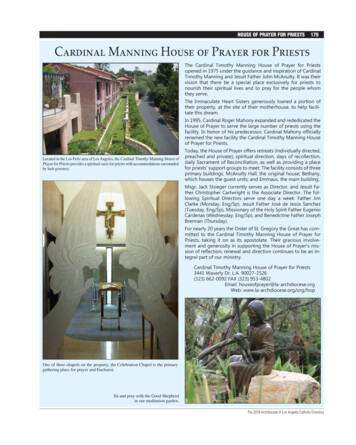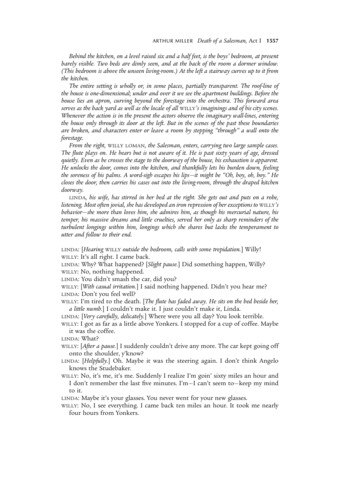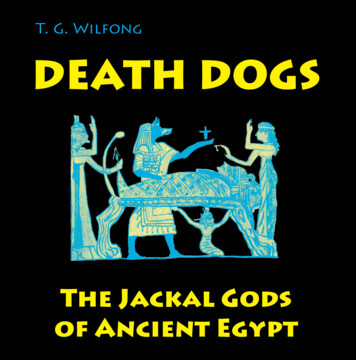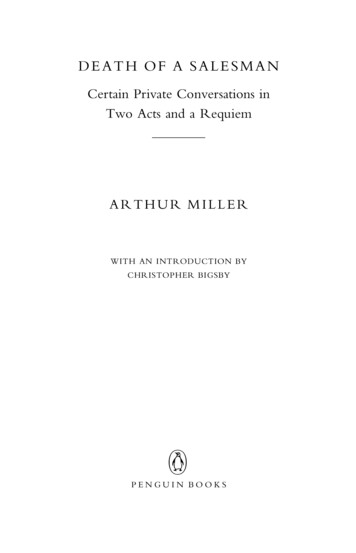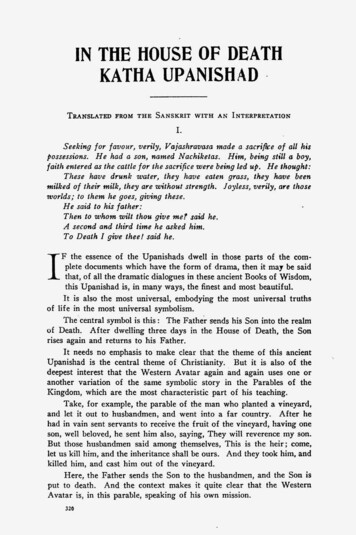
Transcription
IN THE HOUSE OF DEATHKATHA UPANISHADTRANSLATED FROM THE SANSKRIT WITH AN INTERPRETATIONI.Seeking for favour, verily, Vajashravasa made a sacri"e of all hispossessions. He had a son, named Nachiketas. HitH, being still a boy,faith entered as the cattle for the sacrifice were being led up. He thought:Tltese have drunk water, they have eaten grass, they have beenmilked of their milk, they are without strength. Joyless, verily, are thoseworlds; to them he goes, giving these.He said to his father:Then to whom wilt thou give mef said he.A second and third time he asked him.To Death I give thee! said he.F the essence of the Upanishads dwell in those parts of the com·plete documents wh ich have the form of drama, then it may be saidthat, of all the dramatic dialogues in these ancient Books of Wisdom,this Upanishad is, in many ways, the finest and most beautiful.It is also the most universal, embodying the most universal truthsof life in the most universal symbolism.The.central symbol is this : The Father sends his Son into the realmof Death. After dwelling three days in the House of Death, the Sonrises again and returns to his Father.It needs no emphasis to make clear that the theme of this ancientUpanishad is the central theme of Christianity. But it is also of thedeepest interest that the Western Avatar again and again uses one oranother variation of the same symbolic story in the Parables of theKingdom, which are the most characteristic part of his teaching.Take, for example, the parable of the man who planted a vineyard,and let it out to husbandmen, and went into a far country. After hehad in vain sent servants to receive the fruit of the vineyard, having oneson, well beloved, he sent him also, saying, T hey will reverence my son.But those husbandmen said among themselves, This is the heir; come,let us kill him, and the inheritance shall be ours. And they took him, andkilled him, and cast him out of the vineyard .Here, the Father sends the Son to the husbandmen, and the Son isput to death. And the context makes it quite clear that the WesternAvatar is, in this parable, speaking of his own mission.I
IN THE HOUSE OF DEATH321The first three Gospels record this parable. The fourth does not.Yet the fourth gospel conveys exactly the same thought, expresseddirectly and without parable :"For God so loved the world, that he gave his only begotten Son,that whosoever believeth in him should not perish, but have everlastinglife."All four Gospels thus make it dear that the Father sending theSon, with the death of the Son, is, among other things, an acceptedsymbol of the mission of the Avatar; and that the Western Avatar thusused this symbol.But he uses the symbol of the Father and the Son in another way,also, in what is, perhaps, the greatest and most beautiful of all theparables : the story of the Prodigal.Here, it is not the Son of man, but man himself, who is symbolized;man himself, who goes to the place of penitence, and returns thence tohis Father.Using the phrase in one of the texts that bear the name of Shankaracharya, we may say that the Father is the supreme Self, Paramaatma, who sends the Son, the personal self, Jiva-atma, into the world.The personal self dwells there three days. And these three days represent"three times," past, present, future; for the personal self, entering theworld, falls under the dominion of threefold time. Only when, overcoming the world, he reaches liberation, does he "pass beyond the threetimes," as another Upanishad puts it.In one sense, then, the Son whom the Father sends into the worldrepresents the human soul suffering the universal fate. In another sense,the Son is the Avatar.But there is no contradiction, since the Avatar of set purpose subjectshimself to the universal fa te; he takes our nature upon him, and is in aUpoints tempted like as we are, becoming subject to death, in order thathe may show the way of resurrection. As the profoundly philosophicalEpistle to the Hebrews puts it: In that he himself hath suffered beingtempted, he is also able to succour them that are tempted.The whole of the second chapter of this Epistle sheds a flood of lighton the purpose with which an Avatar incarnates, thus making himselfsubject to death; that through death he might bring to nought him thathad the power of death.This last sentence might serve as a superscription for the Upanishadwhich we are considering. It represents the victory over death, gainedthrough the teaching of Death.The Avatar, the Master, subjects himself to the power of death; hetakes upon himself the general fate of mankind, and lives a life which,at every point, shall be representative of that universal fate; all this,in order that he may show mankind the way to overcome the commonfate, to gain the victory over death. He creates situation after situ21
322THEOSOPHICAL QUARTERLYation, performs act after act, in order that, as Christ expressed it, thescripture might be fulfilled; in order that his life might be perfectlysymbolic of the journey of the soul through death to liberation.As has been said before in these comments, it would seem that, onits way toward liberation, the soul of the disciple passes through definiteceremonies, the frame for which is set by those who have already attained,those who have been spoken of as Masters; and that these ceremoniesnot only represent the upward journey of the soul, but also give the soulvital help and inspiration on that journey.It would appear that this Upanishad is the dramatized record ofsuch a ceremony of initiation; that it records not only the fate ofNachiketas, son of Vajashravasa, who descended into the House ofDeath, but also a ceremony actually passed through by disciples who, insuch an initiation, die to the outer world and awake to the world ofimmortality.And, curiously enough, there is still evidence of this character ofthe Upanishad as the record of a ceremony of initiation, in the Sanskrittext itself. For, toward the end of the first half, which completes thestory of Nachiketas, there occur these words: "Arise yel Awake yelHaving obtained your wishes, understand ye !"-all three verbs beingin the plural imperative, and therefore obviously not addressed toNachiketas alone; exactly the words that might be expected to close aceremony of initiation.This, then, is an outline of the symbolism of the whole Upanishad.1t represents the journey of the soul, descending into the House ofDeath, the world of our mortality; dwelling there three days, whichrepresent the "three times," threefold time, perceived as past, present andfuture; and finally rising again from the House of Death, and returningto the Father. And at the same time this symbolism represents theinitiation of a disciple, which initiation is a representation and summingup of the soul's journey to its divine consummation.There is one point of symbolism still to be considered in the passagetranslated: namely, the sacrifice of cattle, which preceded the sacrifice ofthe Son. And it happens that we can once more find the clue of thesymbol in the deeply mystical Epistle of Paul to the Hebrews, andespecially in the tenth chapter:"For the Jaw having a shadow of good things to come, and not thevery image of those things, can never with those sacrifices, which theyoffered year by year continually, make the comers thereunto perfect.For then would they not have ceased to be offered? . . , For it is notpossible that the blood of bulls and of goats should take away sins.Wherefore, when he cometh into the world, he saith, Sacrifice and offeringthou wouldest not, but a body hast thou prepared me: in burnt offeringsand sacrifices for sin thou hast had no pleasure. . Then said he,Lo, I come to do thy will, 0 God. He taketh a ay the first, that he may
IN THE HOUSE OF DEATH323establish the second. By the which will we are sanctified through theoffering of the body of Jesus Christ once for all ."Here, we have exactly the same sequence as in the Upanishad: firstthe sacrifice of cattle, an imperfect and ineffectual sacrifice; then thesacrifice of the Son, made once for all.What then is the significance of this sacrifice of cattle? We mayfind the clue in the Upanishad itself, in the verse which may be translatedthus:"Those of old have called the powers of sense the horses, and theobjects of these powers the pastures, or the roadways."The cattle, then, are the bodily senses, the natural powers of per·ception and action, while the things which they perceive, the thingsupon which they act, are the pastures in which the cattle graze, or theroads on which the horses travel.The sacrifice of cattle symbolically represents a stern asceticismwhich restrains the natural senses and powers, holding them back fromobjects of sense; yet without the full sacrifice of self, without the truesubjection of the heart to the divine law, expressed in the words: "I cometo do thy· will." For the motive of this asceticism may well be spiritualambition, the desire that oneself may excel, that power may be gainedfor oneself; an ambition full of vanity and evil.Therefore there is but one perfect and effectual sacrifice: the sacri·fi.ce of the personal will to the divine Will, the offering of the humanheart to the supreme Heart, the sacrifice of the Son to the Father.As Nachiketas says, the imperfect sacrifice of asceticism can gainonly joyless worlds; as Paul says, it is not possible that the blood ofbulls and of goats should take away sins. Sin lies in the will, and can betaken away only by complete obedience to the divine Will, through theabsolute offering up of all the wills of self.So we come back to the dramatic story of the son of Vajashravasa.Nachiketas has been sacrificed, sent by his father to the House of Death.Standing on the way of death, that all mortals tread, he thus considers:Of many, I go the first; of many, I go the midmost. What is thi.rto be done of Yam-a., f!Jhich through me he will today accomplish!Look after those who have gone before; look toward those who arecoming; as it was with those, so it is with these. As grain a mortal ripens,·as grain he rises again in birth.Nachiketas is standing on the road of death. Many are followinghim; of these he is the first. But he sees also that many have alreadygone before him; therefore he stands in the midst of a perpetual streamof pilgrims.The symbol of seed corn sown in the ground, and there losing itsform and character, yet through that very change giving birth to newlife, would seem to be as old as ancient Egypt, in the days of Osiris. It
324THEOSOPHICAL QUARTERLYis used here, as it is used in the New Testament, as the symbol of resurrection from among the dead. This is the spiritual resurrection, thebirth of the spiritual man, the immortal.Nachiketas goes forward to the door of the House of Death, to seekadmission, and speaks thus:As Vaishvanara, a sacred guest approaches dwellings. Thereforethey give hi1n this greeting of peace: Bring water, oh Son of the Sun!Hope and expectation, friendship and pleasant words, sacrifice andgood deeds, sons and cattle, this destroys, of the man of little wisdom inulhose house a sacred guest dwells without eating.The meaning of Vaishvanara, a title of Agni, god of Fire, wasdiscussed in a former comment. There is the one universal, divine Fire,which, in heaven, appears as the sun; in the mid world, appears aslightning; on the earth, appears as fire on the altar. But the humanbody is also the altar on which this fire burns. This fire is the breath oflife which is common to all men; common, indeed, to all living beingsupon the earth, animals and plants as well as men. The human being,therefore, as the abode of this sacred fire, is sacred, and must be receivedas representative of the god. When the guest comes to the door, godAgni comes to the door. In him, the guest must be greeted.And here there is a touch of humour in the tradition. The guest,representative of the Fire-god, must be greeted with an offering of water,lest the Fire-god burn up the dwelling. The universal presence of thisobligation throughout the East is testified to, by a sentence from anothersacred book: "I entered into thine house, thou gavest me no water formy feet."Water at least must be offered to the guest; and failure to makethis offering, because it is a slight offered to the divinity in the guest,burns up the hope and expectation, the friendship and pleasant words,the merit earned by sacrifice, and even the sons and cattle of the inhospitable man who spurns the guest. Friendly words toward him cease,because even the poorest may greet the stranger with friendly words,and he has failed to do this.Nachiketas, kept waiting three days and nights outside the door ofYama, utters this reproach against Death's inhospitality. Or, as anIndian commentary suggests, the reminder comes from Yama's wife, whorecalls to him the duties of hospitality. The text itself gives no indicationas to who is the speaker ; but it seems more fitting to assign the words toNachiketas himself.We come now to Yama, Lord of death, who is addressed here asDeath, and also as Son of the Sun. Concerning this mysterious personage,there are many traditions in the ancient books of India, from which,perhaps, we may be able to elicit a consistent meaning.
IN THE HOUSE OF DEATH325Yama, with his twin sister Yami, are children of Vivasvat, the Sun.They thus represent the Solar Pitris, the conscious and intelligent soulsof mankind. They are represented as twins, perhaps to indicate theearly races which were two·sexed, before the separation of the sexes.And the tradition that Yama was wedded to his twin sister Yami, nodoubt refers to the period after the separation of the sexes, when sexunion began; the epoch of the later Third Race. The fact that Yamais also called Lord of the South may likewise refer to this Third Race,which had its chief development on the southern continent, as the SecondRace seems to have had its chief development on the nort
KATHA UPANISHAD TRANSLATED FROM THE SANSKRIT WITH AN INTERPRETATION I. Seeking for favour, verily, Vajashravasa made a sacri"e of all his possessions. He had a son, named Nachiketas. HitH, being still a boy, faith entered as the cattle for the sacrifice were being led up. He thought: Tltese have drunk water, they have eaten grass, they have been milked of their milk, they are without
